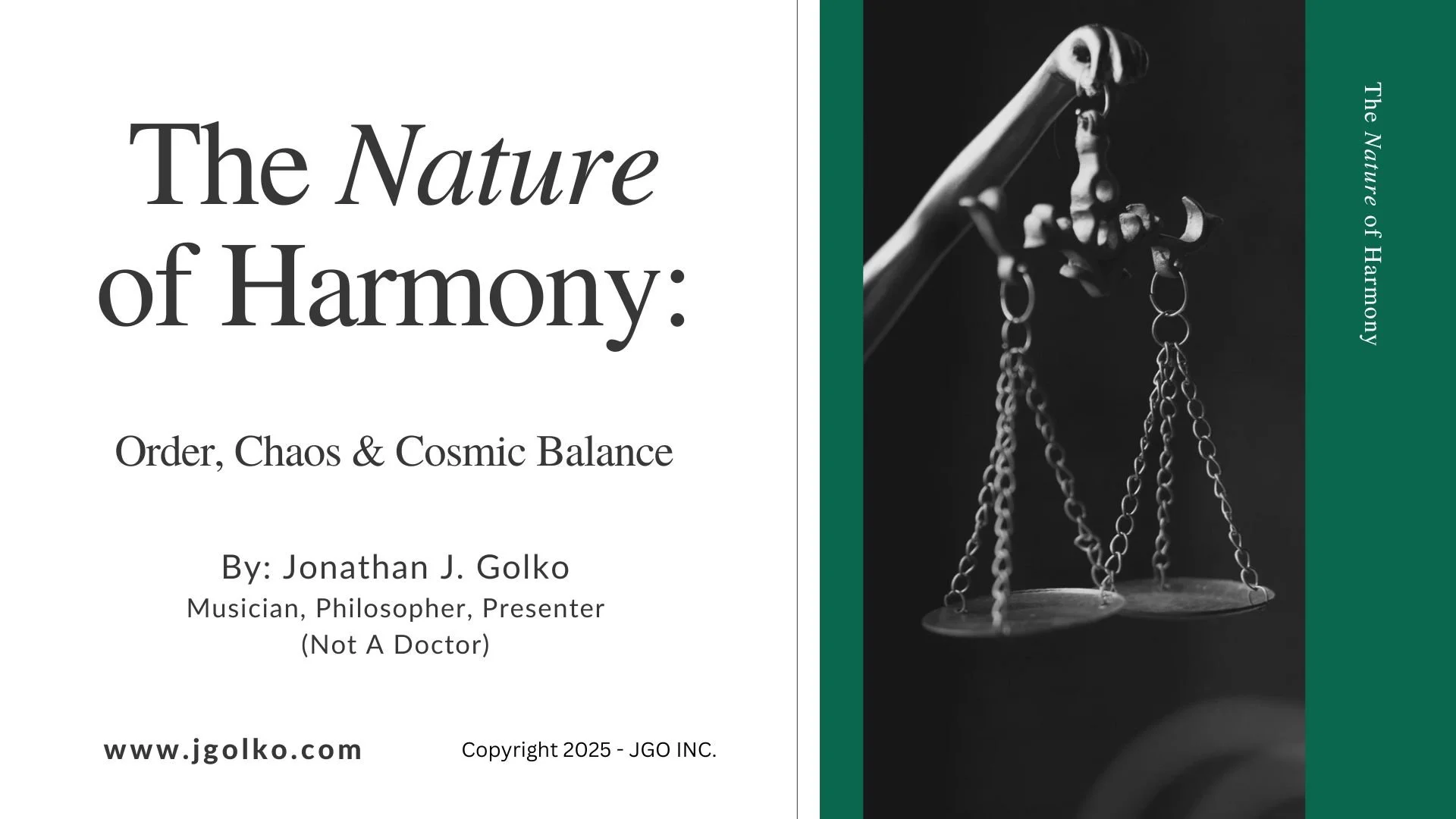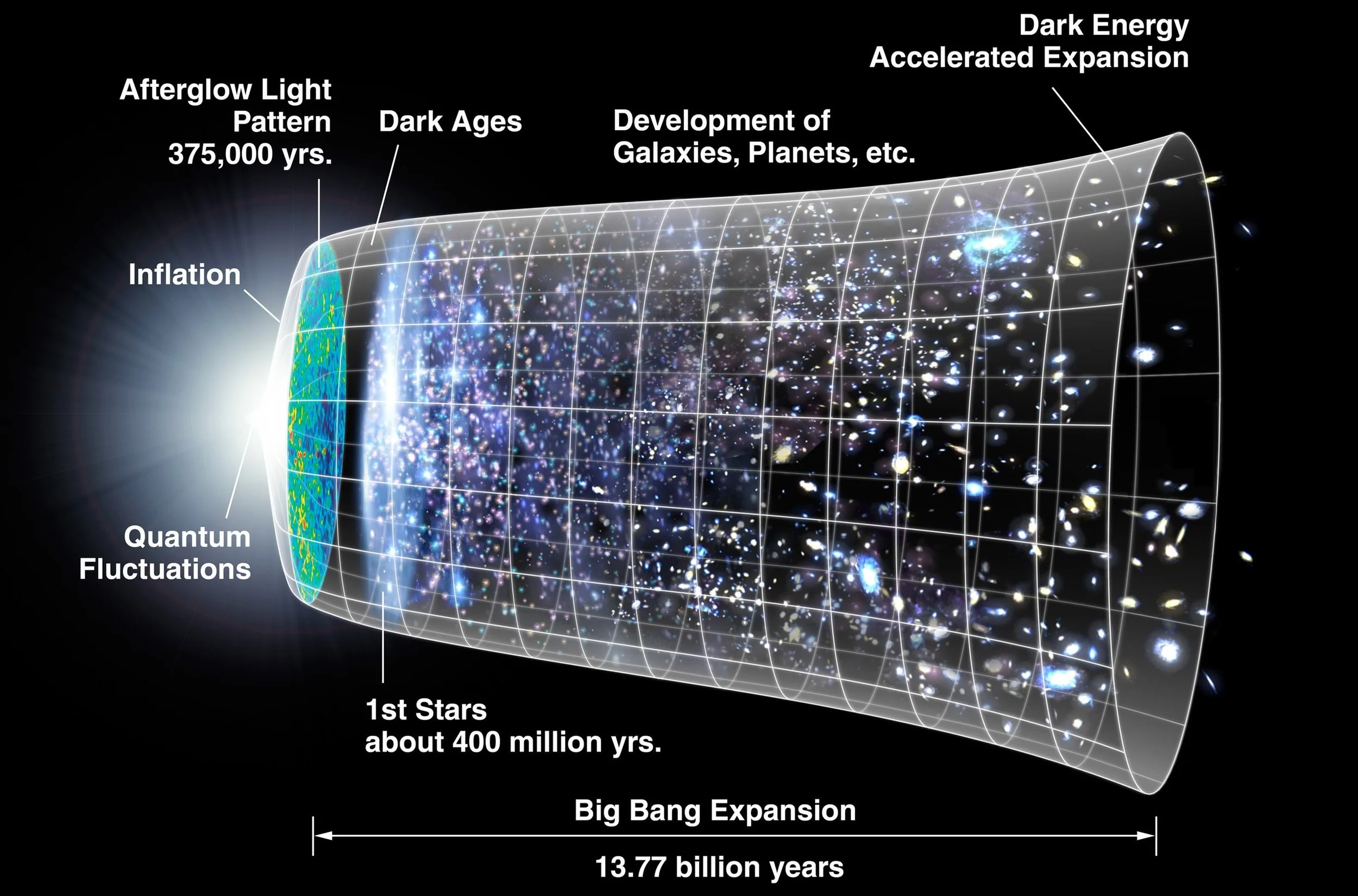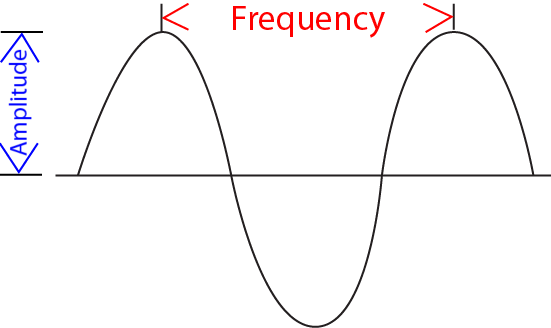THE NATURE OF HARMONY - The Laws of Nature
What began as an innocent project to create a seminar on harmony and introductory music theory, quickly unraveled into a larger, philosophical expedition regarding “harmony” as a force of balance.
Picture Lady Justice. A blindfolded woman wielding a long broadsword in her right hand, and the scales of justice extended outward in her left. The scales, when empty, are at equal weight, and are consequently balanced. Generally speaking, the scale could be considered being “in harmony.”
But to add even the smallest ounce to either scale would tip them out of equilibrium. This balancing act can be observed in many forms within art, society, and the greater cosmos. Upon pulling the thread of the question, “what is the origin of harmony?”, I unintentionally launched into a what would become a research project called “The Nature of Harmony: Order, Chaos & Cosmic Balance.”
Following the completion of my 2022 presentation, “Musical Physics: The Phenomenon of Resonance,” I started to draw parallels between the frequencies of sound waves – i.e. musical notes – and the existence of harmony in art, society, and astronomy.
At the end of the thread, I found the history’s oldest rivalry. Present in all forms of harmony, mythology, and belief systems are the fluid states of order and chaos.
Though man-made religions have a tendency to contradict each other and not see eye-to-eye regarding ethics, human history, and the intentions of divine beings, one narrative they seem to agree on is the restoration of order in an otherwise chaotic universe.
For example, our word “cosmos” is derived from the Greek “kósmos” – which stood for “order” as it pertains to an organized universe; implying that in the beginning there was a period of chaos, followed by a balancing force of order. In astrophysics, this could be interpreted as the Big Bang theory. First, there was an explosion that shot stardust and the first gas elements throughout a timeless, infinite density. The phrase “space-time” is a result of the Big Bang.
Fast forward from the “Rorschach” splatter-birth of the universe to the formation of stars, planets, and black holes, the cosmos begins to establish time due to a series of orbiting objects and elemental evolutions as the universe expanded outward. When the gears of a standard clock are properly functioning, it is said to be “in working order.” So, it’s not a stretch of the imagination to consider that early humans would have linked the clockwork of the stars, moon, and sun to being the divine order of all existence – not knowing life to be any other way.
Of course, Homo sapiens have likely been obsessed with astrology and the question “how did it all begin?” for some 300,000 years, but scientific study of the universe didn’t accurately emerge until the 1600s and the invention of the telescope. A hundred years later, observations in the 1700s of comets, black holes, orbital patterns, and the geometry of the Milky Way gave way to better identification of space entities such as stars, planets, sunspots, and solar cycles in the 1800s.
Given that the Big Bang theory wasn’t suggested until the 1930s, our fascination with exploring the chaotic side of the existence is relatively new - barely a century old.
It’s important to keep the context of the cosmos in mind when considering the role order and chaos play in art and society. The old phrase, “art imitates life, and life imitates art” can arguably go back as far as the idea that in the beginning, there was chaos. And then there was order. Inseparable from each other. In a constant dance of leading and following.
Essentially, we’re talk about the philosophical concept of “duality.” At the most basic, metaphorical level, it’s the two-sided coin. Heads and tails represent different extremes and appear to be opposites, yet they are still one entity. Where order and chaos are two sides of the same coin, then the nature of their implied harmony could be viewed as the fringe perimeter where the two sides meet.
The coin metaphor works as an introductory visual, but it doesn’t represent the nuances of harmony as they exist in other forms of art, society, and astronomy. The coin is engineered to be symmetrical and uniformly balanced (except for the engraving of the heads and tails).
In contrast, works of art employ various degrees of order and chaos to help them convene their underlying message. Harmony, in this way, is the unity of order and chaos. Harmony, though it may be predominantly “orderly” or “chaotic” in its nature, will always contain a mix of the two.
Therefore, the nature of harmony is not to dispel all of chaos and to achieve stark order – it balances the light and the darkness, blends discord and concord, and swings the pendulum of life and death.
Concepts of “good” and “bad” are not applicable when we refer to “order” and “chaos” as they are subjective to the individual and that person’s perception of reality. Rather, we observe order as uniformity, symmetry, and consistency, where chaos is seen as variety, asymmetry, and unpredictability.
In the composition of music, works of art, societal democracies, and the cosmic universe, we find “The Nature of Harmony” to be the collective ‘Yin and Yang’ that achieves a higher unity.
When viewing harmony through the scientific lens of physics, terms like vibration, oscillation, and amplitude naturally exist in artworks, civilizations, and the cosmos. However, we may not notice their presence on the surface level.
When we hear a musical pitch ring out from an instrument, we don’t immediately think about its physical frequency (such as the tone “A” at 440 Hertz). We generally pay most attention to the tone’s quality - whether it’s dark or bright, full-bodied or thin. Secondarily, we listen to the pitch’s context within the chord – whether it has a major, minor, altered, or foundational connotation.
In works of art, such as sculpture, architecture, and painting, we use the “7 Elements” and “11 Principles” of art to breathe life into inanimate nothingness through techniques like color, shapes, movement, rhythm, and proportion. Again, on the surface we see the unified artwork, but in analysis, we find a diverse tapestry binding together elements of order and chaos.
Human society also contains this dynamic in the forms of psychology, ethics, and politics. Civilizations are built on agreed-upon morals and systems of belief, while also competing againstds each other in factions or as parties. Democracy as a political organization is harmony at the civil-level. Where the right-wing and the left-wing may appear to be polar – and at times, extreme – opposites of each other, they are still 2-sides of the same coin.
In the philosophy of science, the law of nature refers to a regularity in phenomena of the world and is labeled as being either universal or probabilistic. For the sake of argument, universal would be associated with order, while probabilistic could be linked to chaos.
The universal law states that some things exist with so much consistency that they are undeniable. Something that is universal in its nature would be gravity on earth – that objects will fall when dropped. Or that the moon orbits the earth. The universal law identifies with consistency.
Conversely, the probabilistic law considers the less-predictable aspects of nature. This would be the law of “chance.” Conditions, such as environment and habitat, always play a role in the development of an entity (be it a human, animal, marine life, or the planets and asteroids hurtling through outer space). Probability takes into account the randomness and statistical variety of any existence.
Returning to our image of Lady Justice’s weight scales, we can visualize harmony as a frequency. As we add to one side, the scale tips. As we add to the other, the scale tips back. Similar effects occur when removing weight from one side or the other. This back and forth action eventually resembles a pendulum – resulting in a measurable frequency due to the rate, speed, and duration of the balance.
The laws of nature are seen in a balancing act between the universal and probabilistic. And here we reach the ground floor of the existence of order and chaos as an oscillating force. Sometimes dominating with order. Sometimes dominating with chaos.
In science and mathematics, we measure these kinds of oscillations as two-dimensional waves, like a sound wave or light wave. Physically, we can imagine water rippling through a pond. The water’s surface lifts upward before briefly falling back to its equilibrium, then continues to recess downwards before rising up to its equilibrium again. This up-down motion is similar to our concept of order and chaos as an occurring, oscillating frequency.
Though wave graphs are generally described as having positive (upward) and negative (downward) trajectories – or amplitudes – we don’t identify these movements as “good” and “bad.” In binary, they would simply be a “0” or “I”. Up or down. On or off. The idea of associating positive with good and negative with bad comes from the language, psychology, and experience of humans.
To the extent that human experience has related the term “chaos” with anxiety and “order” with peacefulness, our individually perceived realities are stimulated and conditioned according to the frequency - or occurrence - of orderly or chaotic environments. The harmony of our lives generally swings between to the two, with periods of the so-called good times and the bad.
And so, we begin to see that the nature of harmony is a never-ending dance between order and chaos.
Where humanity lives between the spiritual realm and the material world – that of non-tangible waves and material mass – we find that the harmony between our spiritual and material selves can be identified as the soul of our being. The unity of a vibrational and physical existence.
Until next time, Hark On!






